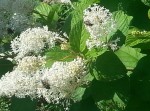 New Jersey tea is a deciduous shrub native to eastern and central North America from Quebec nd Minnesota, south to Florida and Texas where it grows in open woods, rocky slopes, barrens, prairies and roadsides. It is a member of the buckthorn family, Rhamnaceae, and is known for the use of its leaves as a substitute for tea during the Revolutionary War. The oval leaves are up to four inches long and quilted. They have finely toothed margins and are medium to dark green above, and hairy below with a grayish cast. The small white flowers appear from late spring to summer in tight, elongated terminal clusters two inches long carried on long stems. Although the upper part of the shrub is herbaceous, the base is woody with red woody nitrogen fixing roots that are deep and extensive. The flowers attract both butterflies and hummingbirds and the leaves serve as larval hosts for azure and duskywing butterflies. Deer may browse on the leaves and twigs while turkeys and quails eat the seeds. The deep root system make the plant difficult to transplant but enables it to tolerate extreme drought and heat . It is a good choice for dry slopes as well as for foundation planting, mixed borders, or in natural gardens.
New Jersey tea is a deciduous shrub native to eastern and central North America from Quebec nd Minnesota, south to Florida and Texas where it grows in open woods, rocky slopes, barrens, prairies and roadsides. It is a member of the buckthorn family, Rhamnaceae, and is known for the use of its leaves as a substitute for tea during the Revolutionary War. The oval leaves are up to four inches long and quilted. They have finely toothed margins and are medium to dark green above, and hairy below with a grayish cast. The small white flowers appear from late spring to summer in tight, elongated terminal clusters two inches long carried on long stems. Although the upper part of the shrub is herbaceous, the base is woody with red woody nitrogen fixing roots that are deep and extensive. The flowers attract both butterflies and hummingbirds and the leaves serve as larval hosts for azure and duskywing butterflies. Deer may browse on the leaves and twigs while turkeys and quails eat the seeds. The deep root system make the plant difficult to transplant but enables it to tolerate extreme drought and heat . It is a good choice for dry slopes as well as for foundation planting, mixed borders, or in natural gardens.
Type: Deciduous flowering shrub
Outstanding Features: Flowers; tolerance of drought and heat
Form: Compact dense mound
Growth Rate: Slow to moderate
Bloom: Small white flowers in tight, elongated terminal clusters two inches long from late spring to summer
Size: 3-4’ h x 3-5’ W
Light: Full sun to part shade
Soil: Average, dry to medium moist, well-drained
Hardiness: Zones 4-8
Care: Trim to maintain desired shape and size.
Pests and Diseases: Susceptible to leaf spot and powdery mildew
Propagation: Seed, softwood cuttings, semi-hardwood cuttings